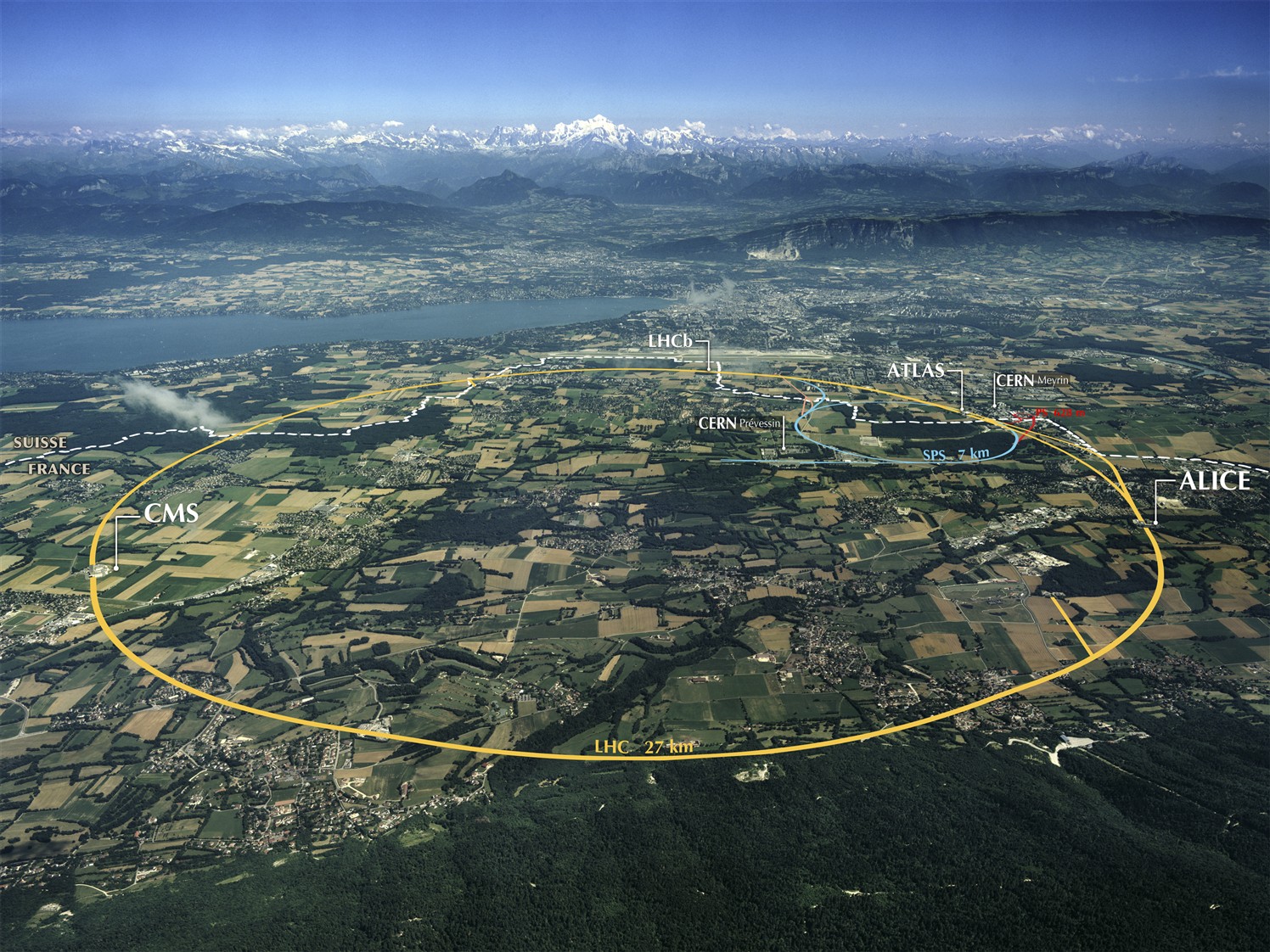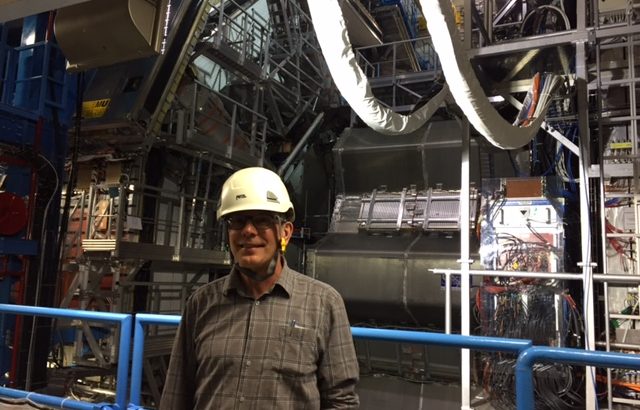by Jamieson Findlay, guest contributor
The European home for big-horizon science is, fittingly, surrounded by an impressive mountainscape. To the north is the Swiss range of the Jura Mountains; to the south, the French Alps. On a clear day, you can see the radiant face of Mont Blanc, Europe’s highest peak, beckoning to tourists and adventurers. If you’ve set your sights on far-out destinations, this is the place to start your journey.
This is CERN, the European Organization for Nuclear Research, a small scientific metropolis just outside Geneva. One hundred meters underground sits the Large Hadron Collider (LHC), the biggest particle accelerator in the world. The LHC is most famous for being the site where physicists finally detected, in 2012, the Higgs boson, a pinion elementary particle that had been eluding them for years. Higgs was more than a particle: it was a sail, finally unfurled. It would carry the ship of modern physics into uncharted seas.
So how’s the voyage going?
A good place to get an update is the ATLAS detector, one of two general-purpose particle detectors at the LHC. In February of this year, I was given a tour of the ATLAS complex by three physicists involved in research there – Richard Teuscher, of the University of Toronto and Canada’s Institute for Particle Physics (IPP); Manuella Vincter, of Carleton University; and Robert McPherson, of the University of Victoria and the IPP.
Our tour began at ATLAS control centre, which you might know if you’ve seen the Hollywood film Angels and Demons (the opening scenes take place there). I was given a handout prepared by McPherson – a big, enthusiastic man who, among his other roles, is Deputy Spokesperson for ATLAS. The handout offered intriguing glimpses into the physicists’ work.
“This is what I live for,” said Vincter, pointing to a phrase in the handout: “Compelling possibility: direct production of dark matter at the LHC.” As team leader of the ATLAS group at Carleton University, Vincter is interested in all the “compelling possibilities” raised by ATLAS data, including this one. Dark matter is the invisible matter that pervades the cosmos.
“You can’t make a universe without dark matter,” affirmed McPherson.
Physicists know it’s there because of its gravitational effects on galaxies. But what exactly is it? One idea is that it is composed of unknown particles that could be produced in particle collisions inside the LHC.
Think of the LHC as a sort of a demolition raceway for elementary particles. It sends two beams of protons spinning at near light-speed around a ring of 27 kilometers. When the beams smash together, the collisions produce “fireworks” of other particles. The energy and speeds involved can reproduce the conditions of the early universe just after the Big Bang.

Aerial view of the region of the Large Hadron Collider, with the collider’s path and associated research complexes indicated.
Donning our hard hats, we descended 100 metres in a crate elevator to the vast complex of computer networks, gas systems and nests of industrial-sized cable that is ATLAS. The LHC had been shut down and ATLAS opened up – not just for me, of course, but for regular maintenance. This meant I’d be able to see into the heart of ATLAS.
It towered almost nine storeys above us, the Mont Blanc of particle detectors. Roughly cylinder-shaped, ATLAS consists of six detection systems layered around the collision point of particles. A powerful magnet system bends the path of the particles around the detection systems to enable close scrutiny.
“If the system were on,” said Teuscher, “the magnetic field would rip a screwdriver out of your hand.” Teuscher, a long-time member of the ATLAS-Canada contingent, oversees graduate and undergraduate students doing Higgs searches and is a leader in the upgrades to the ATLAS inner tracking detector.
It was inside here (and inside the LHC’s other general-purpose detector, the Compact Muon Solenoid) that the famous Higgs boson was detected. Not seen, mind you – just inferred. Higgs left a distinctive signature in the pattern of particle collisions. The elementary particle theorized by Peter Higgs and others had finally been produced… for about a trillionth of a billionth of a second.
That was long enough to start a very big celebration.
For the Higgs particle implied the existence of the Higgs field, essential to modern particle physics. Like the water in a snow globe, the Higgs field was thought to be the invisible medium in which particles swirled. Different particles would interact differently with the field, and these interactions would determine their mass. Their different masses, in turn, would determine how the particles fitted together to create matter. No wonder physicists rejoiced when they finally detected the particle (itself a kind of ripple in the Higgs field). Higgs held their universe together, in more ways than one.
And new physics did seem very likely with Higgs. It was one weird particle.
Consider its mass. We would expect the Higgs mass to be very large – after all, it interacts with many other particles. The energy of those interactions should add up to something very substantial, just as rivulets and streams add up to make a rushing river. But the Higgs mass is ten quadrillion times smaller than it should be. It’s a trickle when it should be a Mississippi. Physicists refer to this as a “naturalness” problem, since the value of the Higgs mass seems contrived, unnaturally small. Why is Higgs just a shadow of itself?
One proposal is that there is a set of undiscovered particles out there, twins of the known particles. These “superpartners” would cancel out the influence of the known particles, acting a bit like channels and conduits near the river, siphoning off the contributing streams. This theory is called Supersymmetry, and its variants constitute the favourite model for physics beyond the Standard Model.
“Supersymmetry solves so many problems simultaneously,” says Vincter. It sends a whole new armada of superpartners sailing in to buttress their subatomic cousins of the Standard Theory. Not only would that armada, in bulk, solve the problem of the Higgs mass, but one or more of these strange vessels might be the dark-matter particle.
Yet another, wilder, solution to the Higgs naturalness problem holds that, yes, the mass of the Higgs is small – but only in this universe. According to this multiverse theory, we are looking at just one of an infinite array of universes, which together offer a kaleidoscope of values for the Higgs mass. The Higgs mass happens to be small here basically through the luck of the draw. It would only be unnaturally small if there were just one universe.
McPherson is not keen on the multiverse idea, which he calls “essentially religious in nature.” At least Supersymmetry is potentially testable at the LHC. So far the LHC data have provided no clear evidence for superpartners, but McPherson is not daunted. “We’ll require several more years of LHC data before we really confront Supersymmetry,” he says.
And there will be plenty of brain-power to tackle all the mysteries connected with the Higgs boson: ATLAS currently brings together 3,000 researchers from 38 countries. Canada is not currently an official partner at CERN, but Canadian universities – and our own national physics laboratory, TRIUMF – have contributed expertise and components to ATLAS. One computer system could not possibly handle all the data generated by ATLAS, and so CERN farms out data to 13 “tier 1” computer centres around the globe, including TRIUMF. Five Canadian universities – University of Victoria, University of Alberta, Simon Fraser, Toronto and McGill – provide tier 2 computer support (that is, specific analysis tasks).
Canada’s expertise is such that Nigel Lockyer, director of the U.S. government particle physics lab Fermilab, has urged Canada to become an associate member of CERN, adding that Canada’s work in dark matter would complement CERN’s efforts.
We may be entering a golden age in physics – or at least, a golden age in physics collaboration. CERN is the biggest collaborative experiment going, and Canada benefits in multiple ways from being a part of this global push to explore the horizons beyond our own horizon.
“At CERN,” says Vincter, “your whole perception of where you are in the universe changes.”
–30–
Jamieson Findlay is a freelance writer based in Ottawa.
Featured image: Jamieson Findlay, onsite at CERN, with ATLAS. Photo: J. Findlay




